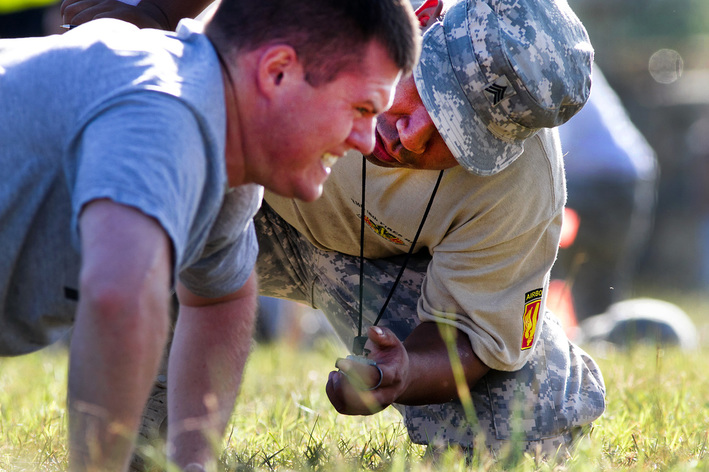 The US Army "Perfect Push Up" CC BY 2.0 The US Army "Perfect Push Up" CC BY 2.0 A challenge in any group exercise class is to pitch the exercises at the right level. Even in settings where I have divided the classes according to level, within each class there will be a range of abilities. I always offer different options, and I see my job as providing you with a challenge to make progress. Equally, each person needs to be honest with themselves about their own capabilities. It is unlikely that there will be one person who is 'the best at everything' and I encourage you to focus on your own journey rather than competing with the others. How hard you work is strongly dependent on your personality and motivation. Some people are happy to tick over maintaining their current level of fitness, whereas others love 'feeling the burn' and will push themselves as hard as they can. So, how hard should you work? One of my favourite sayings in this world of fad exercises is, "The best form of exercise is the one that you actually do." There is little point in exercising harder than you can maintain long term. For cardiovascular effort, there is a scale of perceived exertion (Borg Scale) which runs from 6 (no effort, eg. watching TV) to 20 (maximum exertion that you can only maintain for a short period, eg. sprinting to finish a race) and applies to adults under 65 years of age:
For muscular effort, you will get the quickest results by working to muscle failure. In doing so you risk suffering from sore muscles the next day - and stretching before or after your workout won't prevent it. It is important to recognise when your muscles have reached failure. Beyond this point, it is only possible to continue by executing the exercise with poor technique - using other muscles, poor alignment or momentum to do the work. This is where problem start, and the risk of injury increases. Joseph Pilates is quoted as saying, "A few well-designed movements, properly performed in a balanced sequence, are worth hours of doing sloppy calisthenics or forced contortion." In Pilates, I don't encourage you to work to muscle failure. An important part of Pilates is practising healthy movement patterns, so that they become instinctive. If you reach muscle failure, your technique is likely to be starting to suffer, and you will start to reinforce poor alignment. Should you feel pain during exercise? It depends what you mean by pain. You should feel that your muscles are hot and working hard and this may reach the point of feeling painful, even. This is not a problem, and can be part of a good workout, as long as it doesn't spoil your enjoyment of the activity as a whole. Your muscles will strengthen and it will be more comfortable next time. Any pain in the joints, however, is an indication that you should stop and rest, and choose an easier version next time. If your joints get aggravated and inflamed it will serve no purpose in strengthening you, and will make your next workout feel harder, rather than easier. And here is where you risk long term injury. If your muscles hurt so much that you can no longer continue with good technique, then this is also an indication that you should stop, or choose an easier option that you can continue safely with. If you arrive in class with an injury or pain, let your instructor know - it may be wise to avoid even starting some exercises. Always let your instructor know if an exercise is causing you to feel pain and remember to keep each exercise within your own safe working level. Comments are closed.
|
AuthorFitness and Pilates instructor with a passion for science. Archives
November 2021
Categories |
 RSS Feed
RSS Feed
